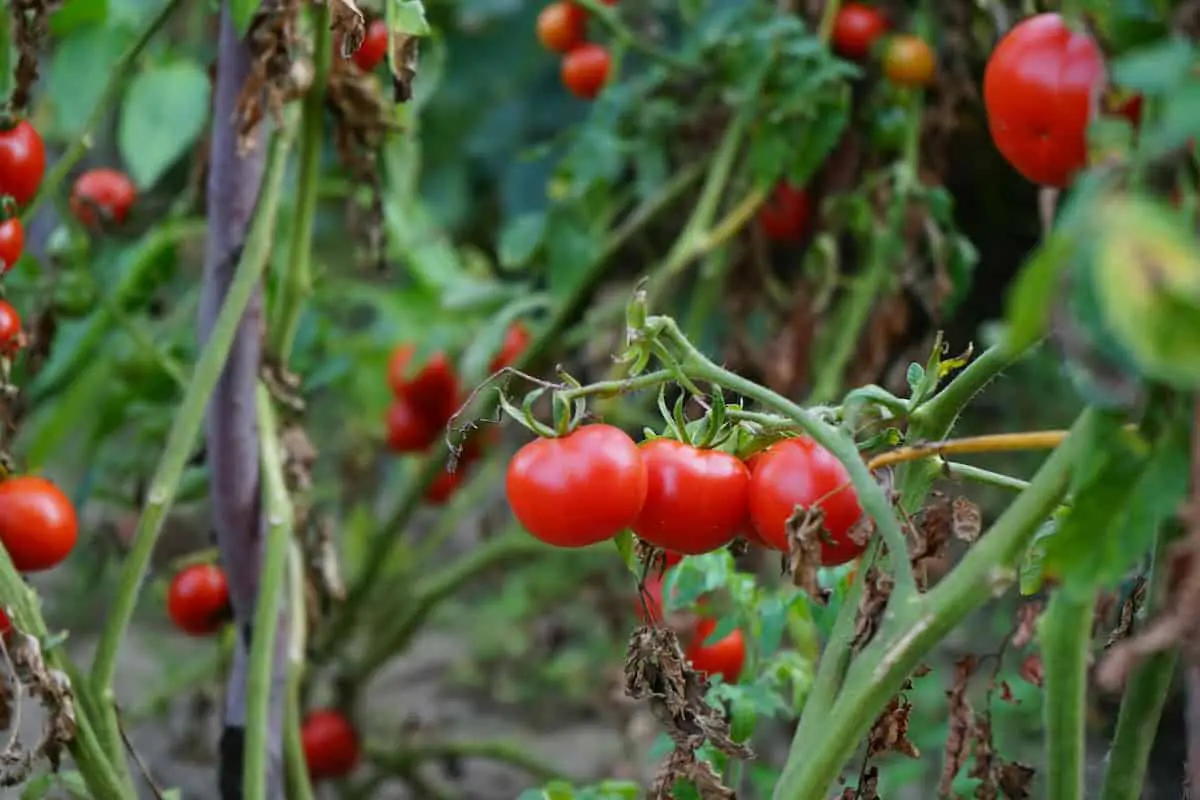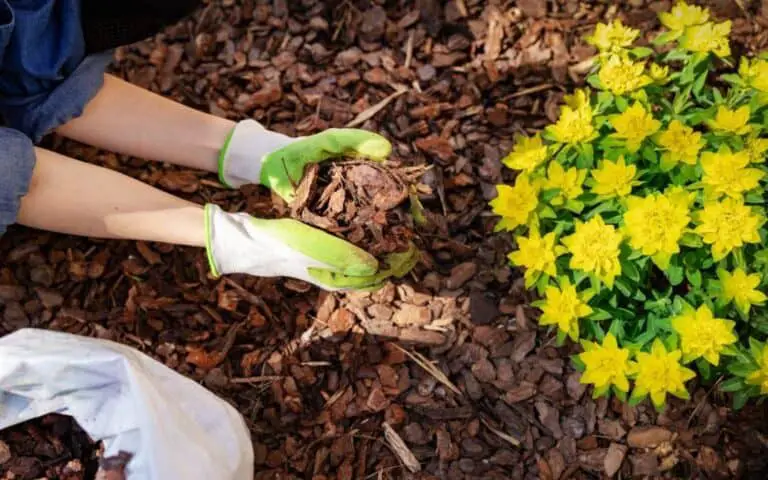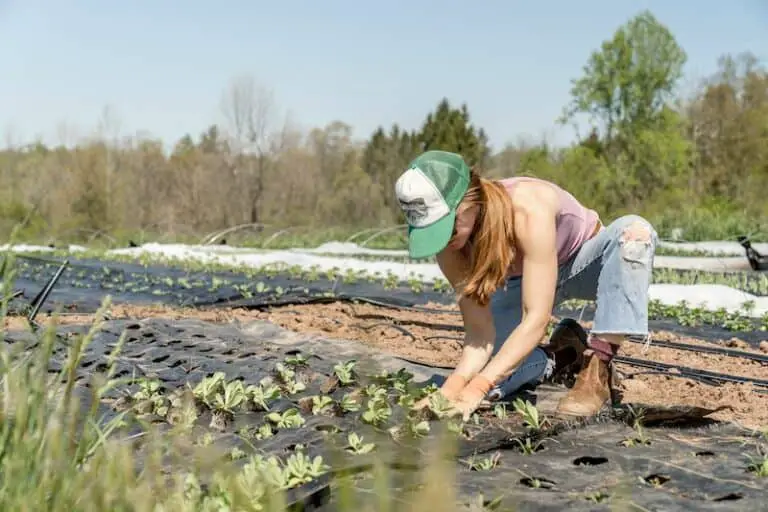Maximize Your Tomato Harvest: 10 Proven Tips for More Tomatoes Per Plant
To get more tomatoes per plant, ensure proper spacing, provide consistent watering, and use high-quality soil. Prune regularly and use mulch to retain moisture.
Tomatoes are a beloved garden staple, prized for their versatility and rich flavor. Achieving a bountiful harvest requires attention to detail and some practical techniques. By following a few essential tips, gardeners can significantly increase their tomato yields. Proper spacing, consistent watering, and high-quality soil are critical factors.
Additionally, regular pruning and the use of mulch can enhance plant health and fruit production. These simple yet effective strategies can lead to a more abundant tomato harvest, ensuring a continuous supply of delicious tomatoes throughout the growing season. With a little effort, anyone can boost their tomato production and enjoy the fruits of their labor.

Credit: www.ruralsprout.com
Choosing The Right Tomato Varieties
To maximize your tomato harvest, selecting the right variety is crucial. Different varieties offer unique benefits. Some are more disease-resistant, while others yield more fruit. Let’s explore how to choose the best tomato varieties for your garden.
Heirloom Vs. Hybrid
Heirloom tomatoes are open-pollinated and often passed down through generations. They are known for their rich flavors and unique shapes. Heirloom varieties can be more susceptible to diseases.
Hybrid tomatoes are bred for specific traits. These include disease resistance, higher yields, and uniformity. Hybrids can be more reliable for beginners.
| Heirloom | Hybrid |
|---|---|
| Rich flavors | Disease-resistant |
| Unique shapes | Higher yields |
| Less disease-resistant | Uniform fruits |
Climate Considerations
Tomato varieties thrive in different climates. Choose varieties suited to your region’s climate. For hot climates, opt for heat-tolerant varieties like ‘Heatmaster’ or ‘Solar Fire’. These can handle high temperatures.
In cooler climates, select early-maturing varieties. These include ‘Early Girl’ and ‘Siberian’. They produce fruit quickly before the first frost. For regions with short growing seasons, look for varieties with shorter maturation times.
- Hot Climates: Heatmaster, Solar Fire
- Cool Climates: Early Girl, Siberian
- Short Growing Seasons: Varieties with shorter maturation times
By choosing the right tomato varieties, you can ensure a bountiful harvest. Pay attention to your climate and the specific traits you need.
Starting Seeds Indoors
Starting seeds indoors gives you a head start on the growing season. It can lead to healthier and more productive tomato plants. Here are some tips to help you begin:
Best Time To Start
The best time to start tomato seeds indoors is 6-8 weeks before the last frost date in your area. This timing ensures that the seedlings are strong enough to be transplanted outdoors.
Seedling Care Tips
Proper seedling care is crucial for healthy tomato plants. Follow these tips for the best results:
- Light: Place seedlings under grow lights or in a sunny window. They need at least 14-16 hours of light daily.
- Watering: Keep the soil moist but not waterlogged. Use a spray bottle to mist the soil gently.
- Temperature: Maintain a temperature of 70-75°F during the day and 65°F at night.
- Air Circulation: Ensure good air circulation to prevent mold and disease. A small fan can help.
Using these tips, you can ensure strong, healthy tomato plants.
Preparing The Soil
Preparing the soil is the first step to growing more tomatoes per plant. Healthy soil provides the foundation for robust tomato plants. It ensures they get the nutrients they need to produce abundant fruit.
Soil Testing
Before planting, test your soil. A soil test reveals its pH and nutrient levels. Tomato plants thrive in slightly acidic soil with a pH of 6.2 to 6.8. You can buy a home soil test kit or send samples to a local extension office.
Soil tests also show nutrient deficiencies. Essential nutrients include nitrogen, phosphorus, and potassium. Knowing the nutrient levels helps you add the right amendments.
Amending The Soil
Once you have your soil test results, you can start amending the soil. Here are some common amendments:
- Compost: Adds organic matter and improves soil structure. It also boosts nutrient levels.
- Bone Meal: Provides phosphorus, essential for root development and fruit production.
- Blood Meal: A good source of nitrogen, which promotes leafy growth.
- Wood Ash: Raises soil pH and adds potassium.
Mix these amendments into the soil thoroughly. Use a garden fork or tiller for even distribution. Always follow the recommended application rates on the packages.
After amending, let the soil rest for a few days. This allows the amendments to integrate fully. Your soil is now ready for planting tomato seedlings.
| Amendment | Benefits |
|---|---|
| Compost | Improves soil structure and nutrient levels |
| Bone Meal | Provides phosphorus for root and fruit development |
| Blood Meal | Supplies nitrogen for leafy growth |
| Wood Ash | Raises soil pH and adds potassium |
Proper Planting Techniques
Proper planting techniques are essential for getting more tomatoes per plant. These techniques help the plant grow strong and healthy. Follow these tips to maximize your tomato yield.
Spacing Matters
Spacing your tomato plants correctly is very important. When plants are too close, they compete for nutrients and sunlight. This results in fewer tomatoes. Keep at least 18-24 inches between each plant. This spacing allows for good air circulation and reduces disease risk.
Depth Of Planting
Plant tomatoes deep to encourage strong root growth. Remove the lower leaves and bury the stem up to the first set of leaves. This method helps the plant develop a robust root system. A strong root system supports more fruit production.
Watering Strategies
Effective watering strategies are crucial to get more tomatoes per plant. Proper watering ensures healthy growth and maximizes yield. Here are some key tips for watering your tomato plants.
Consistent Moisture
Tomato plants thrive with consistent moisture. Watering regularly helps prevent blossom end rot.
- Water plants deeply once or twice a week.
- Check soil moisture with your finger.
- Avoid letting the soil dry out completely.
Mulching Benefits
Mulching offers many benefits for tomato plants. It helps retain soil moisture.
| Benefit | Description |
|---|---|
| Temperature Control | Mulch keeps soil temperature consistent. |
| Weed Control | Reduces weed growth, saving water for the plants. |
| Moisture Retention | Prevents water evaporation from the soil. |
Use organic mulches like straw, wood chips, or grass clippings. Spread a layer of mulch around the base of your plants.
Fertilizing For Growth
Proper fertilization is crucial for getting the most tomatoes per plant. The right fertilizers help plants grow stronger and produce more fruit. Below, we explore the best practices for fertilizing your tomato plants.
Organic Vs. Synthetic
Choosing the right type of fertilizer is essential. Organic fertilizers come from natural sources like compost and manure. They improve soil health and provide slow-release nutrients.
Synthetic fertilizers are man-made and offer immediate nutrients. They are easy to apply and act quickly. Each type has its pros and cons, so choose based on your needs.
| Organic Fertilizers | Synthetic Fertilizers |
|---|---|
| Natural sources | Man-made |
| Slow-release | Immediate action |
| Improves soil health | Quick nutrient boost |
Timing And Frequency
Knowing when and how often to fertilize is key. Start with a balanced fertilizer at planting time. This gives the young plants a strong start.
As the plants grow, switch to a fertilizer high in potassium and phosphorus. These nutrients promote fruit development. Fertilize every two weeks during the growing season.
Always follow package instructions for the best results. Over-fertilizing can harm the plants and reduce fruit yield.
- At Planting: Use a balanced fertilizer.
- Growing Season: High potassium and phosphorus every two weeks.
Pruning And Staking
Pruning and staking are essential techniques to increase tomato yields. Proper pruning helps plants focus energy on fruit production. Staking supports the plants, keeping them upright and healthy. This section will cover removing suckers and using support systems.
Removing Suckers
Tomato plants grow suckers in the leaf axils. These are the little shoots between the main stem and branches. Removing suckers helps the plant concentrate on growing fruits. Follow these steps to remove suckers:
- Identify suckers in the leaf axils.
- Use clean, sharp scissors or your fingers.
- Pinch off suckers when they are small.
- Leave the suckers near the base for bushier plants.
Removing suckers improves air circulation. This reduces the risk of diseases. Plants with fewer suckers produce bigger tomatoes. Make sure to check for new suckers weekly.
Support Systems
Staking keeps plants off the ground. This prevents rot and pests. There are various support systems to choose from:
| Support System | Benefits |
|---|---|
| Stakes | Simple and effective. Tie plants to a single stake. |
| Cages | Encircle plants for all-around support. |
| Trellises | Provide vertical support. Best for indeterminate varieties. |
Choose the best system for your garden. Here are some tips for each:
- Stakes: Use sturdy wooden or metal stakes. Tie plants loosely with garden twine.
- Cages: Place cages early before plants grow too large. Ensure they are anchored well.
- Trellises: Install strong, tall trellises. Tie vines as they grow.
Proper support ensures your plants grow strong and healthy. This leads to more tomatoes per plant. Be consistent with pruning and staking for the best results.

Credit: www.gardenary.com
Pest And Disease Control
Keeping your tomato plants free from pests and diseases is crucial. Healthy plants produce more tomatoes. Here, we’ll discuss common pests and effective treatments to help your garden thrive.
Common Pests
- Aphids: Small, sap-sucking insects that weaken plants.
- Tomato Hornworms: Large green caterpillars that eat leaves and fruit.
- Whiteflies: Tiny, white-winged insects that feed on plant sap.
- Spider Mites: Microscopic pests that cause yellow spots on leaves.
- Cutworms: Caterpillars that cut stems at soil level.
Effective Treatments
- Use Neem Oil to repel and kill pests naturally.
- Introduce beneficial insects like ladybugs to eat pests.
- Apply insecticidal soap for a quick, safe solution.
- Spray plants with water to dislodge pests.
- Remove affected parts to prevent spreading.
Here’s a table summarizing common pests and their treatments:
| Pest | Effective Treatment |
|---|---|
| Aphids | Neem Oil, Beneficial Insects |
| Tomato Hornworms | Hand-picking, Neem Oil |
| Whiteflies | Insecticidal Soap, Water Spray |
| Spider Mites | Neem Oil, Water Spray |
| Cutworms | Hand-picking, Barriers |
Maximizing Sunlight Exposure
Maximizing sunlight exposure is crucial for getting more tomatoes per plant. Tomato plants need a lot of sunlight to grow healthy and produce more fruit. This section will discuss ideal locations and reflective surfaces to help increase sunlight exposure.
Ideal Locations
To maximize sunlight, plant tomatoes in spots that receive full sun. Choose locations that get at least 6-8 hours of sunlight each day.
Consider placing your tomato plants on the south side of your garden. This side usually gets the most sunlight throughout the day.
If you have limited space, use containers. Move the containers to follow the sun as it shifts during the day.
Reflective Surfaces
Using reflective surfaces can increase sunlight exposure for your tomato plants. Reflective surfaces bounce light onto the plants, helping them get more sunlight.
Place white rocks or aluminum foil around the base of your plants. These materials reflect light well and are easy to find.
Another option is to use reflective mulch. Reflective mulch not only helps with sunlight but also keeps the soil warm, promoting better growth.
Setting up mirrors or reflective panels behind your plants can also help. These can direct more sunlight onto the plants, boosting their growth and fruit production.
| Reflective Material | Benefits |
|---|---|
| White Rocks | Easy to find, reflects sunlight |
| Aluminum Foil | Cheap, highly reflective |
| Reflective Mulch | Increases sunlight, warms soil |
| Mirrors | Directs more light to plants |
By using these tips, you can ensure your tomato plants get the sunlight they need. More sunlight means more tomatoes per plant, leading to a more bountiful harvest.
Harvesting Techniques
Knowing the best harvesting techniques can increase your tomato yield. The right methods ensure you get the most out of each plant. Let’s explore some essential tips for proper harvesting.
When To Harvest
Tomatoes are best harvested when they are fully ripe. The color should be deep red, pink, or yellow, depending on the variety. A ripe tomato will easily detach from the vine with a gentle twist. Avoid picking tomatoes too early, as they won’t be as flavorful.
Proper Picking Methods
Use clean, sharp scissors or pruners to cut the stem. Avoid pulling the fruit off the vine to prevent damage. Handle tomatoes gently to avoid bruising. Place them in a basket or container with a soft lining.
For a step-by-step guide:
- Identify ripe tomatoes by their color and firmness.
- Use scissors or pruners to cut the stem close to the fruit.
- Gently place the tomatoes in a soft-lined container.
| Step | Action |
|---|---|
| 1 | Check for ripe tomatoes. |
| 2 | Use clean scissors to cut the stem. |
| 3 | Handle tomatoes gently. |
Following these harvesting techniques ensures more tomatoes per plant. It also helps maintain the health of your tomato plants for future harvests.
Extending The Growing Season
Do you want more tomatoes per plant? Extending the growing season is key. By creating ideal conditions, you can enjoy a longer harvest. Here’s how to do it effectively.
Using Greenhouses
Greenhouses provide a controlled environment for your tomato plants. They protect your plants from harsh weather and pests. This helps your plants thrive and produce more tomatoes.
Key Benefits of Greenhouses:
- Temperature Control: Greenhouses maintain a warm temperature.
- Extended Growing Period: Plant tomatoes earlier and harvest later.
- Protection from Pests: Keeps harmful insects away.
To set up a greenhouse:
- Choose a sunny spot.
- Install proper ventilation.
- Use quality soil and fertilizers.
Cold Frames And Row Covers
Cold frames and row covers are cost-effective alternatives to greenhouses. They help extend the growing season by protecting your plants from frost and cold winds.
Advantages of Cold Frames and Row Covers:
- Ease of Use: Simple to set up and maintain.
- Affordability: Less expensive than greenhouses.
- Versatility: Can be moved around easily.
Steps to use cold frames:
- Build or buy a cold frame.
- Place it over your tomato plants.
- Open it during the day for ventilation.
To use row covers:
- Cover your plants with a lightweight fabric.
- Secure the edges with soil or stakes.
- Remove the cover during warm days.
Use these methods to ensure a longer growing season and more tomatoes.

Credit: www.youtube.com
Frequently Asked Questions
How To Get Lots Of Tomatoes On Your Plant?
Water consistently, use quality soil, and apply balanced fertilizer. Prune suckers and ensure plants receive 6-8 hours of sunlight.
How Do I Get The Most Yield Out Of My Tomato Plants?
To maximize tomato yield, plant in well-drained soil with full sun. Water consistently and use mulch. Prune regularly and use stakes or cages for support. Rotate crops yearly to prevent diseases.
What Is The Secret To Growing Tomatoes?
The secret to growing tomatoes includes choosing the right variety, providing full sunlight, and maintaining well-drained soil. Use organic compost, water consistently, and prune regularly for better airflow.
Conclusion
Growing more tomatoes per plant is achievable with these practical tips. Implement these strategies for a bountiful harvest. Consistent care and attention will reward you with delicious, homegrown tomatoes. Start applying these methods today and enjoy the fruits of your labor.







